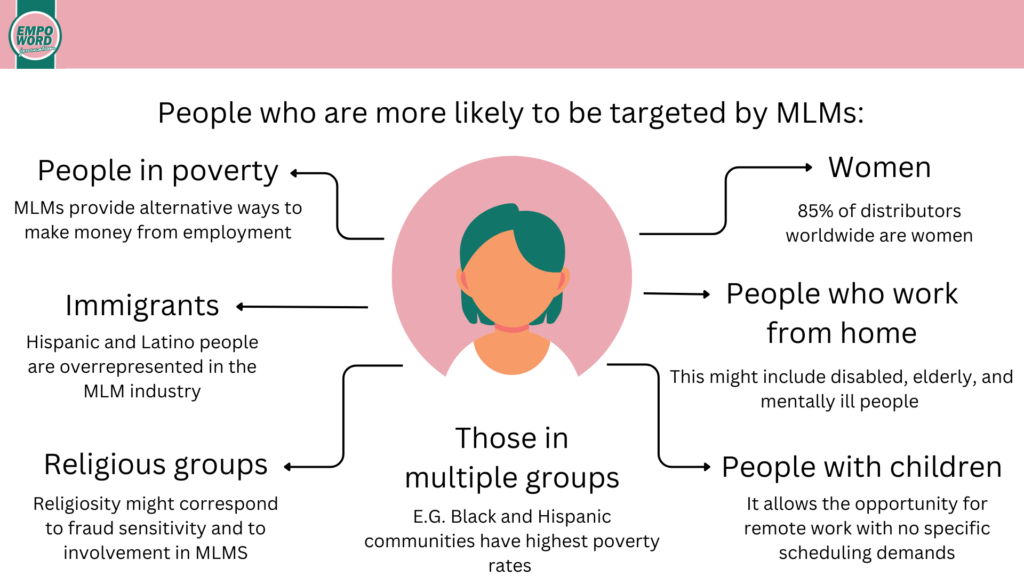Claire Scarborough
Stop me if you’ve heard this one before…
You get a DM on Facebook or Instagram from someone you are loosely acquainted with. It might be a high school classmate, a coworker from a short part-time job, or a friend of a friend you met once. Usually, they start the message with a greeting implying you are closer to each other than you actually are. Probably something along the lines of: “Hey girl/hun/babe/[insert term of affection here]!”
From there, they proceed to tell you how you can be your own boss, while also being a part of a team. They promise better opportunities, more freedom, and, most importantly, more finances. Often, the potential for a (usually monetary) gift will be dangled teasingly, like a carrot, in front of you.
“All you need to do is invest in a starter kit. Then, you’ll easily make the money back, before your business thrives!” They’ll claim.
What are MLMs?
MLMs, or multi-level marketing businesses, are direct-selling companies. A seller purchases a certain amount of the product to sell to customers while recruiting others to do the same. In most business models, the seller receives a commission for any sales made by those in their “downline”, which is where the majority of wealth-building in the industry comes in. Typically, the earlier one gets into an MLM, the better their chance of turning a profit is.
Knowledge of MLMs and their predatory practices are becoming more mainstream, thanks to hit documentaries like Prime Video’s ‘LuLaRich’. However, they still have a devoted following and manage to cultivate increased numbers of people. Direct Selling Association reports 6.2 million Americans (about 1.8% of the American population), are currently involved in direct selling or multi-level marketing. A staggering 99% of people end up losing money when they participate in a MLM, according to the Consumer Awareness Institute.
Chances are you’ve heard of an MLM before, even if you didn’t recognise that it was one at the time. DoTerra, Pampered Chef, Herbalife, Amway, and many more fall under the umbrella of multi-level marketing.

What’s the problem with MLMs?
Most MLMs are, for the large part, perfectly legal. But they have become notorious for a number of predatory practices, including preying on vulnerable or marginalised groups. These include lower-income individuals, those with chronic illnesses, military spouses, elders, and more. It’s such an issue, the American Association of Retired Persons (AARP) has dedicated materials to teach senior citizens about the risks.
Several characteristics the aforementioned groups have in common, (like isolation, a lack of flexibility in their schedules, and stretched finances), are what MLMs manipulate. “Boss babes,” “huns”, or whatever term you’d prefer look specifically for people in these demographics. Simply put, those people are the easiest to convince that the scheme will fix their issues. These people, who are already down on their luck or are disadvantaged due to prejudices, need a break in order for life to get better.
People such as:
- The young mom who has moved across the world, with her soldier husband and their small children, away from everyone and everything she knows.
- The man trying to get back on his feet after losing his job, desperate to find anything that will pay quickly.
- Someone sick, unable to get out of bed, or leave their house that often, with no connection to the world outside of their phone.
- The retired grandma, with few friends, a phone she doesn’t quite know how to work, and all the time in the world on her hands.
Why people join MLMs
MLMs promise friendship and community to people, who are at a point in their lives where they desperately need such things. Some promise the products themselves will cure the ailments elderly people or the chronically ill have, conditions for which they’ve tried a bevy of remedies with little-to-no relief.
They present an opportunity: a chance to meet new people, achieve your dreams, or pull yourself out of debt. It doesn’t matter if you have to pay money to enter the businesses or that MLMs don’t offer the benefits associated with typical full-time jobs, like health insurance and paid sick and vacation time. It doesn’t matter only 25% of MLM participants turn a profit. You have a community now, friends who want to see you succeed as much as they’re succeeding.
How people become trapped
By continuing to pretend, the recruiter keeps the vulnerable person in their downline and continues to profit off them. Once the person starts becoming unsure of whether they will continue with the MLM – whether they aren’t receiving the desired results or realising direct selling is not for them – it becomes a matter of the recruiter attempting to convince them to stay. Therefore, the recruiter can keep making money off of them.
One more sale, they say. One more week spent grinding, surely then your business will start taking off. It’s a lie.
Once the person escapes the MLM for good, communication with the recruiter who seemed to be a friend dries up. They move on to their next victim without a second thought.
The MLM continues this pattern of predatory behavior with no remorse. Meanwhile, the person who is sick, alone, or in dire financial straits is once again alone and isolated. They’re probably even more broke than before they got involved in the MLM.
One day, they get a new message on Instagram: “Hey hun!”
The cycle continues.
READ NEXT:
-
WORKPLACE SEXISM IN THE “ZOOM ERA”
-
THE DANGERS OF AI IN PORNOGRAPHY
-
TIKTOK’S “LUCKY GIRL SYNDROME”: MANIFESTATION OR PRIVILEGE?
Featured image courtesy of Jonas Leupe on Unsplash. Image licence found here. No changes were made to this image.

